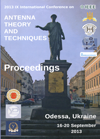Excitation of fast pulse guided wave in receiving dielectric rod antenna
DOI:
https://doi.org/10.1109/ICATT.2013.6650806Keywords:
dielectric rod antenna, pulse signal, BOR-FDTD, Cherenkov effect, dielectric waveguideAbstract
During the propagation of pulse signal in dielectric waveguide Fast Pulse Guided Wave is forming. This wave propagates at the head of pulse signal in the waveguide and has rhombus-shape field distribution inside the dielectric with inclined like-Cherenkov wave front. Another part of this wave propagates near the dielectric surface in free space with the speed of light in free space. The rhombus shape structure inside the rod also propagates with the speed of light in free space. Fast Pulse Guided Wave is similar to some mode in the waveguide, however it doesn’t save own field distribution in different cross-sections. The goal of this article is considering the plane wave diffraction at the taper dielectric rod (receiving rod antenna) and investigation of the Fast Pulse Guided Wave excitation in dielectric waveguide in this case. As a calculation method BOR-FDTD technique was used.References
LEGENKIY, M.; BUTRYM, A. Excitation and propagation of a fast pulse guided wave in a circular dielectric waveguide. Radiophysics and Radioastronomy, 2013, v.18, n.2, p.147-151.
BUTRYM, A.Y.; LEGENKIY, M.N. Properties of pulse surface waves in a dielectric waveguide. Proc. of 6th Int. Conf. on Ultrawideband and Ultrashort Impulse Signals, 17-21 Sept. 2012, Sevastopol, Ukraine. IEEE, p.309-311, doi: http://dx.doi.org/10.1109/UWBUSIS.2012.6379814.
TAFLOVE, A.; HAGNESS, S.C. Computational Electrodynamics: The Finite-Difference Time-Domain Method. New York: Artech House, Inc.
WENHUA, Y.; MITTRA, R. Parallel Finite-Difference Time-Domain Method. New York: Artech House.
LEGENKIY, M.; BUTRYM, A. Nonstationary Electromagnetic Field Propagation in Dielectric Waveguide. Physical Bases of Instrumentation, 2012, v.1, n.1, p.23-35.
DAVIDSON, D.B.; ZIOLKOWSKI, R.W. Body-of-revolution finite-difference time-domain modeling of space-time focusing by a three-dimensional lens. J. Opt. Soc. Am. A, 1994, v.11, n.4, p.1471-1490, doi: http://dx.doi.org/10.1364/JOSAA.11.001471.

